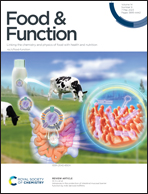A comparative study on the allergenic potential of β-lactoglobulin conjugated to glucose, caffeic acid and caffeoyl glucopyranose†
Abstract
This work intends to perform a comparative study on the allergenic potential of β-lactoglobulin (BLG)–glucose, BLG–caffeic acid and BLG–caffeoyl glucopyranose conjugates. The modifications changed the molecular weight and multi-structure of BLG and destroyed the allergenic epitope, which resulted in a decrease in the IgE binding level and the release ability of histamine and IL-6 in KU812 cells. Compared with BLG, the conjugates reduced the serum levels of IgG, IgE, β-Hex and IL-4 in vivo, while increasing the level of interferon-γ, which caused an imbalance of Th1/Th2 immune response. Meanwhile, these conjugates not only increased the relative abundance of allergy-related gut flora, such as Lachnospiraceae, norank_o_Clostridia_UCG-014, Erysipelotrichaceae, Turicibacter and Lachnospiraceae_NK4A136_group, but also improved the level of short-chain fatty acids (SCFAs). Caffeoyl glucopyranose with a large molecular weight and long carbon chains exerted a great influence on the allergy-related gut flora and SCFAs. Therefore, the changes in the Th1/Th2 balance and SCFA level produced by the allergy-related gut flora were responsible for reducing the potential allergy of BLG.



 Please wait while we load your content...
Please wait while we load your content...